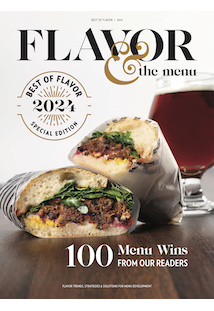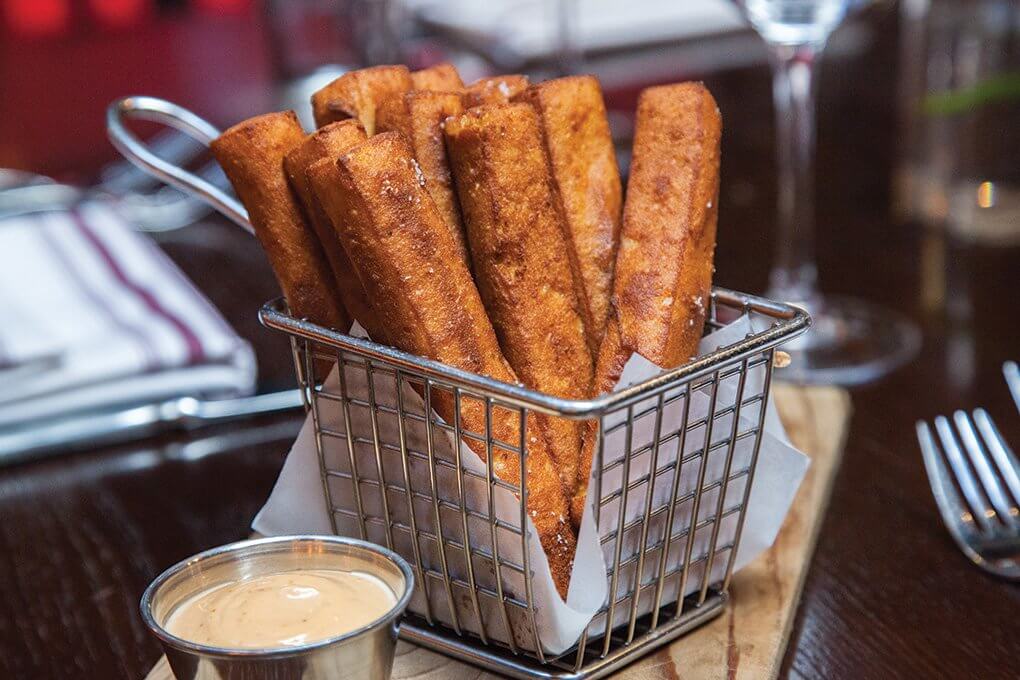Chickpeas used to be relegated to salad bars, often hidden in a pool of liquid, rescued by a slotted spoon and served as a nod toward healthful eating. Then, the world discovered hummus, which has built a beautiful bridge to other chickpea wonders. Now, they’re found in hearty salads, like the one at Tanta in Chicago, which sports mixed greens with chickpea escabeche, cilantro, mint, parsley, queso fresco, cucumber and onion. And they’re served as a comforting shareable in a farinata, an Italian street food starring chickpea flour, found at Officine Brera in Los Angeles. At Absinthe in San Francisco, they appear as a bar snack of fried chickpeas with berbere spice and parsley. Today, the chickpea, a member of the pulse family and often touted for its superfood attributes, is chic. Giving it extra oomph, the United Nations declared 2016 “the year of the pulse.”
Three main pillars have elevated its status. First: consumer interest in plant-based options. Much like the veg-centric trend helped propel cauliflower and Brussels sprouts into rock-star glory, menu creativity around plant-based proteins has helped shape innovation around chickpea usage. Second: the blossoming love affair with Eastern Mediterranean, Middle Eastern and Indian cuisines. Deeper exploration into this flavor-forward part of the world has revealed chickpeas in various textures and formats, while also pairing them with big, bold, beautiful flavors. Third: forward-thinking menu development in bowl builds, salad concepts and bar bites. This movement has tapped the chickpea—as a wholesome garnish, or glazed with harissa and maple syrup, or as a swoosh of hummus offering textural counterpoint, or a crisp fritter served with a curried dipping sauce.
“You have an ingredient that will do well almost exclusively because of its incredible versatility but, happily for the chickpea, that’s not the only thing it has going for it,” says Maeve Webster, president of Menu Matters. “Chickpeas can now gain greater acceptance among larger shares of consumers, thanks to the penetration and acceptance of hummus. It’s a different format, but the flavor is now very familiar to many, if not most consumers, so the leap to eating other versions of chickpeas is not nearly as great as it might have been 10 years ago.”

Here, chickpea flour and ground roasted peanuts form falafel bites, proving their potential as a base for flavor innovation.
Hummus 2.0
Hummus has catapulted from a dip found almost exclusively in Middle Eastern-themed restaurants to a universal shareable in foodservice and a consumer go-to for family get-togethers and book club meetings. Its familiarity is so embedded in our culture that 48 percent of consumers are likely to order hummus in a restaurant, according to Datassential. At its simplest, hummus is a spread or dip made from chickpeas, tahini, olive oil, lemon juice and garlic. Now that it is understood and welcomed by diners, chefs are putting creative spins on their offerings. “Hummus is on fire and being crafted in a lot of exciting ways,” says Kathy Casey, chef and mixologist. “From vibrant-colored beet hummus to Thai coconut hummus, the possibilities are there for incorporating new flavors and variations.”
Rotisserie Ema, a fast casual in Chicago, features a hummus bar with six flavors, from black olive to sweet pea and mint. At Hummus Kitchen, with three locations in New York, guests can choose from offerings like Grilled Vegetable Hummus, topped with seasonal vegetables, and Shawarma Hummus, topped with thinly sliced chicken and grilled onions. Michael Mina’s pop-up kitchen called Middle’terranea in San Francisco, features hummus topped with fried cauliflower, crisp chicken skin, dried cherries and marjoram. Shaya, in New Orleans, serves a Curried Fried Cauliflower Hummus, topped with caramelized onion, curry and cilantro. Last year, Dallas-based Which Wich Superior Sandwiches added a Superfood Wich to its menu, with a vegan black bean patty, quinoa, housemade jalapeño hummus, fresh avocado and roasted red pepper, all wrapped in a flour tortilla. Panera also turned to flavored hummus as a spread, featuring it in handhelds like its Mediterranean Chicken Flatbread, a whole-grain flatbread filled with chicken, curried lentil hummus, feta, cucumber, napa cabbage and tzatziki.
And although bowls dotted with crispy chickpeas are somewhat par for the course now, hummus is finding its way into modern builds, too. The Mediterranean Bowl at California Tortilla combines romaine, pearl couscous, Israeli salad, cucumber and hummus, topped with grilled mesquite chicken, tzatziki, avocado, feta and California Screamin’ hot sauce.
“I’m a huge fan of chickpeas,” says Maira Isabel Morales, corporate executive chef and director of R&D at Schlotzsky’s, a sandwich concept with more than 350 units. “They can go so many ways—Asian, Middle Eastern, Spanish, Portuguese, Italian. For a fast casual or quick-serve, we want ingredients that can perform in multiple ways. It’s a no-brainer for us. I like the idea of a Cuban hummus with black beans, garlic, cumin, olive oil and sour orange; served with pork rinds.”

Panera replaces mayonnaise with a cilantro-jalapeño hummus in its Mediterranean Veggie Sandwich, which also stars Peppadew peppers, tomato and feta cheese.
Falafel and Other Fritters
Crispy, craveable and versatile, it’s no surprise falafel is now making moves on U.S. menus. Seen traditionally ensconced in fluffy pita with tahini, maybe with white onions and the fiery hot s’chug, it’s now getting a more Americanized treatment, borrowing from the fish taco build—without losing any of its craveable cred. The falafel taco at Bartaco, with multiple locations on the East Coast, serves a cigar-shaped falafel in a corn tortilla, topped with tzatziki. Domo Taco in New York offers a Kimchi Falafel Taco, with miso slaw, pico de gallo and cheddar-Jack cheese. In Los Angeles, Ihsan’s Falafels adds a Sudanese touch, subbing out tahini with a spicy peanut sauce, while Gjusta, in Venice, Calif., serves a falafel sandwich on a toasted baguette.
Bar bites and sides are also taking a look at chickpeas, understanding how well they take on texture and flavor. “The authenticity and relevancy of chickpeas for many on-trend world cuisines is a benefit,” says Webster. “Various preparations can significantly change the texture—whether the chickpea is mashed, roasted, spiced, candied or battered.”
The chickpea fries at David Burke Fabrick in New York, consist of chickpea flour cooked in milk, seasoned with fennel pollen, salt and pepper, set in a deep pan, then cut and deep fried. “The slightly salty, crispy outside of the chickpea fries mixed with the nutty, creamy interior makes these craveable” says Michael Franey, Fabrick’s executive chef. They’re served with chipotle aïoli.
At Urban Farmer in Cleveland, a seasonal Harvest Tomato Soup is served with chickpea fritters, cilantro and cumin oil.
“I think there’s big opportunity with the chickpea burger,” says Schlotzsky’s Morales. “It’s got a neutral flavor that you can build on, from a Middle Eastern profile with tahini, garlic and lemon to a Mexican profile with chile peppers, lime and cilantro.” The chickpea burger holds potential for creative interpretation. As evidence, look to Fare Well in Washington, D.C., where a mushroom-chickpea burger is adorned with walnuts, sunflower seeds, aïoli and caramelized onion.
The Whole Chickpea
Although there are so many wonderful ways to spread, dip, mash or fritter the chickpea, leaving it whole can be pretty magical, too. Whole chickpeas are showing up now—roasted, flavored and served as a bar snack. At Encantada in Baltimore, crispy chickpeas are seasoned with barbecue spices. Chefs are also turning to them for topping salads, bowls and soups. Forbidden Root in Chicago offers a kale and spinach salad garnished with fried chickpeas, fennel, herbs and fried shallots, and dressed with a tahini-orange dressing. Spice-roasted chickpeas top a Chopped Kale Salad, with Parmesan, sunflower seeds and Champagne vinaigrette, at Hudson Hil’s Cafe in Cold Spring, N.Y.
“Fried and seasoned chickpeas are a great gluten-free crouton alternative,” says Kathy Casey. “Also, fresh, green chickpeas in the pod are a fun alternative to edamame. They just need a quick cook, then toss them with berbere spices and serve with a fresh lime.”
Chickpeas can be a significant player in many of today’s most influential menu trends—from international cuisines and plant-based proteins to modern bowl and salad builds.










